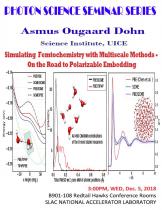Speaker: Asmus Ougaard Dohn, Science Institute (UICE)
Program Description:
In recent years, we have developed and implemented a multiscale Quantum Mechanical / Molecular Mechanical (QM/MM) Born-Oppenheimer Molecular Dynamics method, coupling DFT codes to point charge-based force fields (PCFFs)[1, 2], with a fast and robust description of excited states[3]. These tools have many applications, such as analysing solvent stabilization of charge separation[4], or predicting solvation processes following bond formation around the active-site of an Ir-based photocatalyst. The simulations can also help facilitate the interpretation of time-resolved x-ray scattering data from the LCLS[5].
For many processes, e.g. charge-transfer, polarizability of the solvent is a crucial factor, which is lacking from QM/MM models based on PCFFs. Thus, we are developing a polarizable embedding model with mutual polarization, such that both MM di- and quadropoles are polarized by the QM electronic density and vice versa. This substantially improves the QM/MM description of the hydrogen bonding network of water in systems ranging from the water dimer to liquid water, and will thus hopefully further improve the predictive qualities and quantitative accuracies of our simulation framework.





